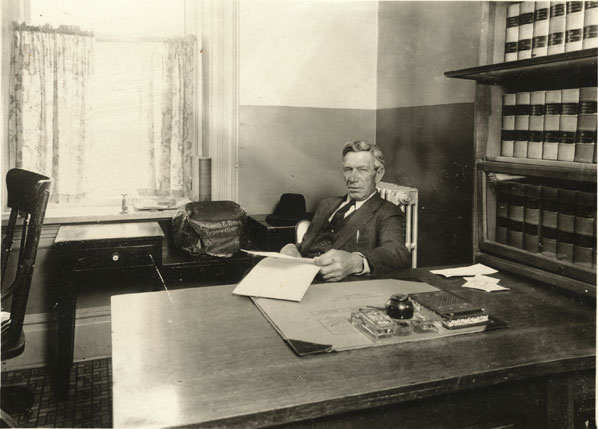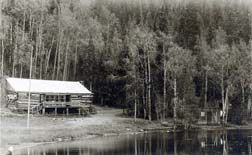Taken from Monuments To Courage – A History of Beaver County
The mountains, known as the Tushar Range, east of Beaver City, are full of ideal places for outdoor recreation, fishing,
hunting, and camping. The fishing up and down the river is always good; the scenery is majestic with the peaks and densely
wooded mountain sides, with wild flowers native to the region in great abundance. As one proceeds up the canyon, numerous
and picturesque camping places are to be found.
If it is desired to visit the lakes, Puffer will possibly be first consideration, a trip of about 20 miles up the highway.
On the way to Puffer, the road leads to many beautiful spots, going through Merchant Valley with its abundant fishing streams,
also passing through the Box Canyon with its straight-up-and-down cliffs, covered with vines and flower; as one leaves the
canyon and one comes to Britt’s Meadows. In this valley is the outing home of the Y. W. M. I. A., where a commodious
log cabin has been built; also the ranger’s splendidly-built quarters, enclosed with a fence of logs very artistically
built.
Farther along the highway is Lake Otter, a small lake but with fine fishing.
Splendid accommodations are available at the lodge, built on the shore of the lake,
and also are provided here at small cost for the use of tourists.
Taken From The Puffer Lake Utah State Web Site
Introduction
Puffer Lake is high in the Tushar Mountains east of Beaver. While it is not particularly
large, it is the largest natural lake found in the Tushars. The area around the reservoir
is privately owned but access is unrestricted. Defined beneficial uses include: water
recreation excluding swimming; propagation of cold water species of game fish and aquatic
life; and agricultural needs.
Recreation
Puffer Lake is 18 miles east of Beaver and 16 miles west of Junction on U-153. The
highway from Beaver is paved, while the highway from Junction, although steep, is
gravel and maintained in good condition. Currently efforts are underway to widen
and improve the road from the reservoir towards the east. Puffer Lake and the surrounding
area is entirely privately owned by the Puffer Lake Resort, but public access is
permitted through agreements with DWR that allow for fishery access to the lake.
Facilities at the resort include: camping, cottage rental, boat rental, boat
launching, and fishing. picnicking, showers, horseback riding, and a convenience
store. Puffer Lake receives heavy fishing pressure during the summer season.
The nearest USFS campground, Mahogany Cove, has 7 campsites, vault toilets,
and picnic facilities. Fees are charged. It is 7 miles west of Puffer Lake on
U-153. There are also several private campgrounds in Beaver.
Watershed Description
The reservoir is in a deep glaciated valley south of Mount Holly in the
Tushar Range. The watershed high point, the south shoulder of Mount Holly, is 3,597 meters
(11,800 ft) above sea level, thereby developing a complex slope of 19.8% to the reservoir.
The inflow and outflow is Lake Stream, and the average stream gradient above the reservoir
is 8.8% (647 feet per mile). Cullen Creek also flows into the reservoir. The soil is
largely of volcanic origin with moderate permeability and moderately slow erosion and runoff.
The vegetation communities are comprised of pine, aspen, spruce-fir, oak, maple and
alpine vegetation. The watershed receives 76 - 102 centimeters (30 - 40 inches) of precipitation
annually with a frost-free season of 0 – 20 days at the reservoir.
PUFFER LAKE
A mile along the highway from Lake Otter is Puffer Lake, named for
James Puffer, who discovered it in 1865. This is a glacial lake in a beautiful setting,
surrounded by the high pine-clad mountains; the high peaks of Mt. Belnap, Baldy, and
Delano, a few miles distant looking down upon it, and from their snow-covered peaks
it is fed.
Plenty of room is found here for camping, all free. Fishing is good,
either from the shore or from the lake and boats can be rented for a reasonable price.
It is only a short drive on Highway No. 21 up to and across the Big Flat to
what is called the rim or east line of Beaver County. The view from this point is unsurpassed
for grandeur. To the south, as far as the eye can reach, can be seen the wonderful mountains
of the Bryce Canyon, Cedar Breaks and the Grand Canyon. To the north and east the mountains
and valleys, with their towns and villages making a panorama of beauty, and to the west the
high peaks and mountains of Nevada, surely a sight once seen, never to be forgotten.
The Big Flat is a natural meadow, on which a modern home is built for the
convenience of the ranger.
On crossing this flat near sundown, one may be favored with a sight of large
herds of deer feeding on the meadow.
There are many interesting places to visit around Lake Puffer that can easily
be reached by means of good Government trails, either on foot or by horseback. The high peaks can
thus be reached without much trouble.
On the return trip down the canyon, signs are placed along the highway, guiding to
places of interest, one of which will point the road to Kent’s Lake, High Lo, and the Little
Reservoir which are also favorite fishing sites.
Written by Norma Easton
In 1924, I married Morris Thompson. He worked for his dad in the meat market and drove a
school bus.
In 1927 in partners with my dad, Neils Jensen, who was sheriff at the time we
bought the Puffer Lake cabins and Lodge.

We ran this resort until Morris was stricken with a ruptured appendix and died in 1930.
I thought that I would never live again, but after five years I met Ray Easton
and my life changed again.
Written by: Richard Easton
The Puffer Lake resort was actually purchased from the Utah Power & Light
who owned all of the surrounding land for a 99 year lease. When Morris died in 1930, Norma was not able
to run the resort with the help of her dad. Her sister Clerynth and her husband Ed Larson stepped in
to help and took over the management of the resort.
Ed was working for the Union Pacific railroad and living in Milford, Utah. Norma was content
to let them manage the resort along with her father Neils Jensen. Shortly after Ed and Clerynth
stepped in, they had to have the property signed over to them for insurance purposes.
Ed continued to work as a conductor on the Union Pacific Railroad and I am not sure
whether he took the summers off or drove back and forth. John Williams also worked as a conductor for the
railroad and Ray Easton worked as a car inspector, also for the railroad. For as long as John and Faye
Williams lived in Milford, Utah, their son Clare would spend most of the summer with Ed and Clerynth
at Puffer Lake.
Ed, Neils and Ray Easton built several new cabins North of the Lodge on the hill and also
over by Blanies Dam, the lake as you came into the valley where the Puffer Lake lodge stood
just to the East of Otter Lake.
During the deer season, that ran, usually the second and third weeks of October, Ray would
take his horses to the lake so that he and Ed could haul the deer down from the bald ridges that were to the
North of Puffer Lake. These mountains had peaks Delano, Baldy, and Belknap that were around 12,000 feet high. The
lodge itself was about 9,000 feet above sea level while Puffer Lake which was North of Otter Lake was at an
elevation of 9,672 feet above sea level. Several hunters came every year from California and stayed in the
cabins for the entire two weeks of the deer season. Clerynth would serve meals for the hunters during deer season.
Ed and Clerynth continued to run the resort until about 1963 when they sold it to Darrell Schram from Milford
Utah. Darrell owned the Ford & Lincoln car dealership in Milford and bought Puffer Lake for approximately
$100,000 and a new Lincoln every 2 or 3 years. As I recall, Ed and Clerynth had 3 new Lincoln Continentals.
Written by: Candy Lish Fowler
When I was growing up, Mom, Dad, Danny and I spent every summer there . . .
Dad usually took all his vacation at Puffer Lake and when that ran out, he drove to SLC to go back to work during
the week while mom, Dan and I stayed. He came back to Beaver on weekends. Mom and dad helped Aunt Clerynth and
Uncle Ed. Mom cleaned cabins and everything else Aunt Clerynth needed. Dad helped with woodcutting, repairs on
the lodge and cabins. They tried to help-out all they could. When I was about 13, (about 1962 or 63) I recall
Aunt Clerynth and Uncle Ed asking mom and dad if they wanted to buy it. There were some long discussions in our
home about the possibility. When mother and daddy could not buy it, the lodge and cabins were sold and I was broken
hearted.


